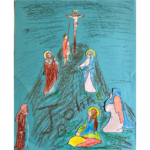
Tradition plays a key role in the legacy left by the saints of the early Church so that what we know is very often based on ‘oral tradition rather than written accounts.’
It is traditionally believed that St. Lawrence was born on the 31st December 225, in Huesca, a Spanish town in the region later known as Aragon, that formed part of the Roman Province. It is believed that his parents Orientius and Patientia also came from this region, so there is no doubt that he was ‘ a real historical personality.’
Lawrence was brought up in a Christian family and received a sound education in the Christian Faith in Saragossa. Even in his youth Lawrence felt he was called to the priesthood. At one point in his youth he met Sixtus, a Greek philosopher and an Archdeacon in Rome who was visiting Spain on Church matters. Sixtus recognized the potential in Lawrence, so he invited him to accompany him to Rome. Lawrence left his country and travelled from Spain to Rome becoming Sixtus’ protege. When Sixtus became Pope, he ordained Lawrence as a deacon and later as ‘Archdeacon of Rome.’ This meant that young Lawrence, being the first of the seven deacons serving in the Cathedral Church, held a position of great trust being responsible for the Church funds and the distribution of alms to the poor and needy.
In 257, Emperor Valeriano declared a persecution of all Christians and the confiscation of all the belongings of the Church. Christians were forbidden to practise their faith. Those who did not abide by the decree of the Emperor were harshly punished or martyred. Pope Sixtus made arrangements for the relics and sacred objects to be moved to a safe place, while he continued to celebrate liturgical functions in the catacombs. It was during one of these functions that he was arrested and later beheaded in the Roman temple of Mars.
It is believed that while Pope Sixtus was being escorted, Lawrence caught up with him, grieving for his friend and spiritual father. The Pope told him that they would be meeting within 3 days and directed him to distribute all the riches that he could, to all those in need.
Lawrence himself was soon arrested and besides being accused of being a Christian, he was also accused of not returning the belongings of the church to the Emperor. Even during his short time in prison, Lawrence continued to spread the Faith, even baptizing others to Christianity.
Cornelius the Prefect of Rome, felt that even in prison Lawrence was a threat to the Roman beliefs, so he offered Lawrence a release from prison if he brought to the State ‘the treasures of the church.’ Lawrence demanded a period of 3 days to be able to achieve this. He returned to the Prefect at the stipulated time and presented him with a crowd of elderly, the sick, the blind, the crippled, stating “These are the treasures of the Church.”
Lawrence was then tortured for refusing to worship the pagan gods. It is believed that he was bound to a heated iron grill so that his body burned slowly until he died. However some historians state that after this torture he was beheaded as was the Roman practice of martyrdom.












